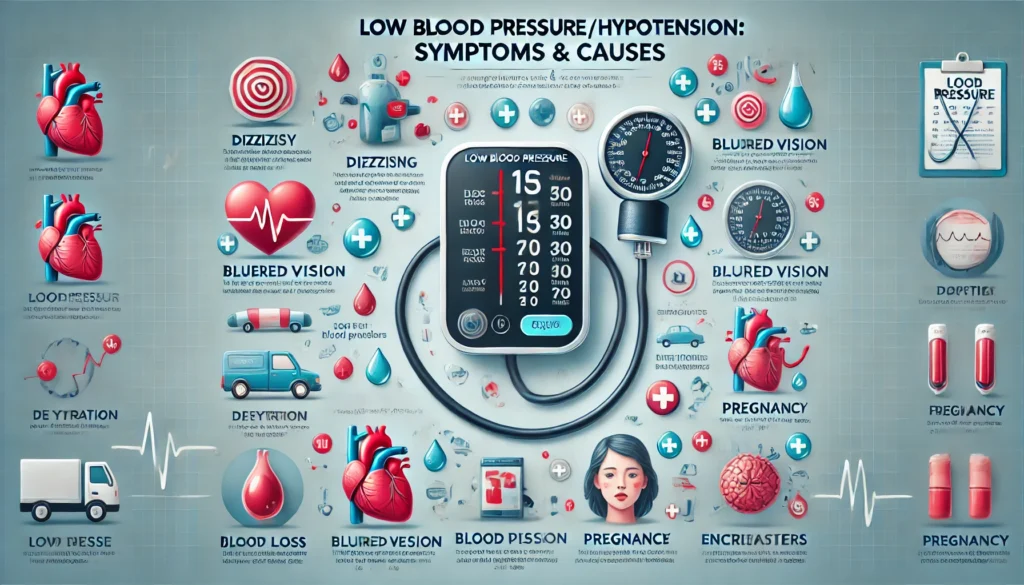
What is Low Blood Pressure?
Low blood pressure, also known as hypotension, is a condition where the force of blood against the walls of the arteries is lower than normal. Blood pressure is measured in millimeters of mercury (mmHg) and is expressed as two numbers: systolic pressure (the pressure when the heart beats) over diastolic pressure (the pressure when the heart rests between beats). A normal blood pressure reading is typically around 120/80 mmHg. Hypotension is generally defined as a reading below 90/60 mmHg.
While low blood pressure is often considered less dangerous than high blood pressure, it can still cause symptoms and complications, particularly if it leads to inadequate blood flow to vital organs like the brain, heart, and kidneys. In some cases, hypotension can be a sign of an underlying health issue that requires attention.
Range of Low Blood Pressure
Blood pressure readings can vary, but the following ranges are generally used to classify low blood pressure:
- Normal: 90/60 mmHg to 120/80 mmHg
- Low (Hypotension): Below 90/60 mmHg
- Severely Low: Below 60/40 mmHg (requires immediate medical attention)
It’s important to note that some people naturally have low blood pressure without experiencing any symptoms or health issues. However, if low blood pressure causes symptoms or is linked to an underlying condition, it should be addressed.
Low Blood Pressure by Age: A Detailed Overview
Low blood pressure, or hypotension, can affect individuals of all ages, but its causes, symptoms, and implications often vary depending on age. While some people naturally have low blood pressure without any issues, others may experience symptoms or complications, especially if hypotension is linked to an underlying condition. Below is a breakdown of how low blood pressure manifests across different age groups:
1. Low Blood Pressure in Children and Adolescents
Normal Blood Pressure Range for Children:
Blood pressure in children is categorized differently than in adults. It is based on percentiles relative to age, sex, and height. Generally, a reading below the 5th percentile for their demographic is considered low.
Common Causes:
- Dehydration: Common in children due to illnesses like vomiting, diarrhea, or insufficient fluid intake.
- Nutritional Deficiencies: Lack of iron, vitamin B12, or folate can lead to anemia and low blood pressure.
- Infections: Severe infections (e.g., sepsis) can cause a drop in blood pressure.
- Heart Problems: Congenital heart defects or arrhythmias may lead to hypotension.
- Allergic Reactions: Severe allergies (anaphylaxis) can cause a sudden drop in blood pressure.
Symptoms:
- Dizziness or lightheadedness
- Fatigue
- Fainting
- Pale skin
- Rapid breathing
Treatment and Prevention:
- Ensure proper hydration, especially during illness or physical activity.
- Provide a balanced diet rich in essential nutrients.
- Monitor for signs of infections or allergic reactions.
- Consult a pediatrician if symptoms persist or worsen.
2. Low Blood Pressure in Young Adults (18-40 Years)
Normal Blood Pressure Range: 90/60 mmHg to 120/80 mmHg
Low blood pressure in this age group is often benign, especially in physically active individuals or athletes. However, it can sometimes indicate an underlying issue.
Common Causes:
- Dehydration: Due to intense exercise, hot weather, or inadequate fluid intake.
- Orthostatic Hypotension: A sudden drop in blood pressure when standing up.
- Medications: Certain drugs, such as antidepressants or blood pressure medications, can cause hypotension.
- Pregnancy: Hormonal changes and increased blood vessel dilation often lead to lower blood pressure during pregnancy.
- Eating Disorders: Conditions like anorexia nervosa can cause malnutrition and low blood pressure.
Symptoms:
- Dizziness or lightheadedness
- Blurred vision
- Fatigue
- Nausea
- Fainting
Treatment and Prevention:
- Stay hydrated, especially during exercise or in hot climates.
- Eat small, frequent meals to prevent postprandial hypotension (a drop in blood pressure after eating).
- Avoid standing up too quickly.
- Monitor medications and discuss side effects with a healthcare provider.
3. Low Blood Pressure in Middle-Aged Adults (40-60 Years)
Normal Blood Pressure Range: 90/60 mmHg to 120/80 mmHg
In this age group, low blood pressure may be more concerning, especially if it is linked to chronic health conditions.
Common Causes:
- Heart Conditions: Issues like bradycardia, heart valve problems, or heart failure can lead to hypotension.
- Endocrine Disorders: Conditions like hypothyroidism or adrenal insufficiency (Addison’s disease) can cause low blood pressure.
- Medications: Blood pressure medications, diuretics, or drugs for Parkinson’s disease may lower blood pressure.
- Chronic Dehydration: Often due to inadequate fluid intake or excessive use of diuretics.
- Postural Hypotension: More common in this age group due to age-related changes in blood vessel elasticity.
Symptoms:
- Dizziness or lightheadedness
- Fatigue
- Difficulty concentrating
- Cold, clammy skin
- Fainting
Treatment and Prevention:
- Manage underlying health conditions like heart disease or thyroid disorders.
- Adjust medications under medical supervision.
- Increase salt intake (if recommended by a doctor).
- Wear compression stockings to improve blood flow.
4. Low Blood Pressure in Older Adults (60+ Years)
Normal Blood Pressure Range: 90/60 mmHg to 120/80 mmHg
Low blood pressure is more common in older adults and can be more dangerous due to the increased risk of falls and injuries.
Common Causes:
- Age-Related Changes: Blood vessels lose elasticity with age, making it harder for the body to regulate blood pressure.
- Medications: Older adults often take multiple medications, some of which can lower blood pressure.
- Chronic Conditions: Diabetes, Parkinson’s disease, and heart disease are common in this age group and can contribute to hypotension.
- Postprandial Hypotension: A drop in blood pressure after eating, which is more common in older adults.
- Dehydration: Older adults are at higher risk of dehydration due to reduced thirst sensation or mobility issues.
Symptoms:
- Dizziness or lightheadedness
- Fainting (increased risk of falls and fractures)
- Confusion or difficulty concentrating
- Weakness
- Blurred vision
Treatment and Prevention:
- Monitor blood pressure regularly.
- Adjust medications to minimize side effects.
- Eat smaller, more frequent meals to avoid postprandial hypotension.
- Stay hydrated and ensure adequate fluid intake.
- Use mobility aids if dizziness or fainting is a concern.
When to Seek Medical Attention
Low blood pressure is not always a cause for concern, but certain situations require immediate medical attention:
Persistent Symptoms: Dizziness or fatigue that does not improve with lifestyle changes.
Severe Symptoms: Fainting, confusion, or difficulty breathing.
Signs of Shock: Cold, clammy skin, rapid heartbeat, or weak pulse.
Causes of Low Blood Pressure
Low blood pressure can result from a variety of factors, including temporary conditions, lifestyle choices, and underlying medical issues. Common causes include:
- Dehydration: Insufficient fluid intake or excessive fluid loss (e.g., from vomiting, diarrhea, or sweating) can reduce blood volume, leading to low blood pressure.
- Heart Problems: Conditions like bradycardia (slow heart rate), heart valve problems, or heart failure can impair the heart’s ability to pump blood effectively.
- Endocrine Disorders: Thyroid issues (hypothyroidism), adrenal insufficiency (Addison’s disease), or low blood sugar (hypoglycemia) can cause hypotension.
- Blood Loss: Significant blood loss from injury, surgery, or internal bleeding reduces blood volume and pressure.
- Severe Infection (Septicemia): Infections can lead to a life-threatening drop in blood pressure called septic shock.
- Nutritional Deficiencies: Lack of essential nutrients like vitamin B12 and folate can cause anemia, leading to low blood pressure.
- Medications: Certain drugs, such as diuretics, beta-blockers, and antidepressants, can lower blood pressure.
- Pregnancy: Blood pressure often drops during pregnancy due to hormonal changes and increased blood vessel dilation.
- Postural (Orthostatic) Hypotension: A sudden drop in blood pressure when standing up from sitting or lying down.
- Neurally Mediated Hypotension: A miscommunication between the heart and brain, often triggered by standing for long periods.
Symptoms of Low Blood Pressure
The symptoms of low blood pressure vary depending on its severity and the individual. Common symptoms include:
- Dizziness or Lightheadedness: Especially when standing up quickly.
- Fainting (Syncope): A temporary loss of consciousness due to reduced blood flow to the brain.
- Blurred Vision: Caused by insufficient blood supply to the eyes.
- Fatigue: Persistent tiredness or lack of energy.
- Nausea: A feeling of queasiness or discomfort.
- Cold, Clammy Skin: Due to poor circulation.
- Rapid, Shallow Breathing: The body’s attempt to compensate for low oxygen levels.
- Difficulty Concentrating: Reduced blood flow to the brain can impair cognitive function.
- Weakness: A general feeling of physical weakness or lack of strength.
In severe cases, low blood pressure can lead to shock, a life-threatening condition characterized by confusion, rapid heartbeat, and cold, sweaty skin. Immediate medical attention is required in such situations.
Progression of Low Blood Pressure
If left untreated, chronic or severe low blood pressure can lead to complications, including:
- Organ Damage: Inadequate blood flow can damage the brain, heart, and kidneys over time.
- Falls and Injuries: Fainting episodes can result in falls, fractures, or other injuries.
- Shock: A severe drop in blood pressure can cause shock, which is a medical emergency.
- Cognitive Decline: Chronic low blood pressure may contribute to memory problems or dementia in older adults.
Medical Treatment for Low Blood Pressure
Treatment for low blood pressure depends on its cause and severity. Common medical interventions include:
- Addressing Underlying Conditions: Treating the root cause, such as heart disease, infections, or hormonal imbalances.
- Medications:
- Fludrocortisone: Helps increase blood volume.
- Midodrine: Constricts blood vessels to raise blood pressure.
- Intravenous (IV) Fluids: Used in cases of severe dehydration or blood loss.
- Blood Transfusion: Necessary in cases of significant blood loss.
- Lifestyle Adjustments: Doctors may recommend dietary changes, increased fluid intake, or compression stockings to improve blood flow.
Natural Treatment for Low Blood Pressure
For mild cases of low blood pressure, natural remedies and lifestyle changes can help manage symptoms. These include:
- Increase Salt Intake: Sodium helps raise blood pressure, but this should be done under medical supervision.
- Stay Hydrated: Drinking plenty of water prevents dehydration and maintains blood volume.
- Eat Small, Frequent Meals: Large meals can cause a sudden drop in blood pressure. Smaller meals help maintain stable levels.
- Include Nutrient-Rich Foods: Focus on foods high in vitamin B12, folate, and iron to prevent anemia.
- Herbal Remedies:
- Licorice Root: Can help raise blood pressure by retaining sodium.
- Rosemary Oil: Used in aromatherapy to improve circulation.
- Avoid Alcohol: Alcohol can lower blood pressure further.
- Compression Stockings: These help prevent blood from pooling in the legs and improve circulation.
Prevention of Low Blood Pressure
Preventing low blood pressure involves adopting healthy habits and managing risk factors. Key preventive measures include:
- Stay Hydrated: Drink enough fluids, especially in hot weather or during exercise.
- Eat a Balanced Diet: Include foods rich in essential nutrients to support overall health.
- Avoid Sudden Position Changes: Stand up slowly from sitting or lying down to prevent orthostatic hypotension.
- Exercise Regularly: Physical activity improves circulation and cardiovascular health.
- Limit Alcohol: Excessive alcohol consumption can lower blood pressure.
- Manage Stress: Chronic stress can contribute to low blood pressure. Practice relaxation techniques like yoga or meditation.
- Monitor Medications: Be aware of medications that may lower blood pressure and discuss alternatives with your doctor if needed.
Conclusion
Low blood pressure, while often less concerning than high blood pressure, can still pose significant health risks if left unmanaged. By understanding its causes, symptoms, and progression, individuals can take proactive steps to address the condition through medical treatments, natural remedies, and lifestyle changes. Prevention is key, and maintaining a healthy lifestyle can help keep blood pressure within a normal range. If you experience persistent symptoms of low blood pressure, consult a healthcare professional to identify and treat any underlying issues. Remember, your health is your greatest asset, and taking care of it ensures a better quality of life.
